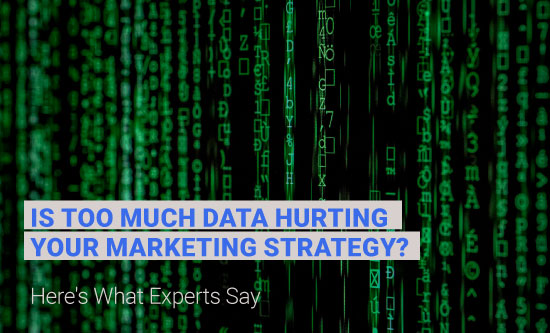Is too much data hurting your marketing strategy? Learn how to cut through the deluge to find meaningful metrics, gain better insights and grow your brand.
Chief marketing officers (CMOs) have more data than ever before at their fingertips. From digital to lead generation metrics, they must dedicate resources to data collection, analysis and, of course, the consequent actions.
CMOS often battle through data issues — having too much, too little or not trusting the information they have — and it’s ratcheting up the pressure to deliver results, often leading to errors.
One of the top data challenges for CMOs as they move into 2022 is figuring out which metrics matter. Tons of metrics are available, including social media shares, web hits, heat mapping, content click rates, MQL counts, lead conversion rates and more.
“The real issue is which of these metrics are the ones that really matter to building the business,” said Tyler Shields, CMO at JupiterOne. “The best CMOs are bridging the gap between data specific to marketing and data that drives the business.” Depending on the specifics of the business and the go-to-market model, the metrics all play at a different level of importance.
A modern CMO must connect the value of each of these metrics with the type of business to determine where to focus their time, energy and budget for the best return on investment.
Related Article: How to Start Analyzing Before the Data Arrives
CMOs Should Work With Data Pros in Other Departments
Shields noted that CMOs must connect traditional marketing technologies such as marketing automation tools, SEO optimization and web metrics directly to the business intelligence that results as an outcome.
“More and more CMOs should be looking towards traditional BI style tools to dive deeper into results-driven marketing efforts,” he said. “First and foremost, a modern CMO has to be a data person themselves.”
Shields explained that if CMOs rely on someone else to build and run the marketing and business data analytics program, they won’t be intimate with the results and won’t truly understand how they are derived.
“Rely on the finance and marketing data people to work together to build the metrics vision that tracks your data from lead creation to revenue,” he added. “The executive suite will buy off on this vision when you can provide them with business analytics value and help you get the resources you need to deliver.”
Avoid Data Hoarding, Integrate Data Across the Organization
Caroline Carruthers, co-founder of global data consultancy Carruthers and Jackson, said when she talks to CMOs today, she sees them suffering from what she calls data hoarding, where they’ve got too much data and they can’t make decisions on it.
“Basically, they collect everything and that blocks all the pathways of thinking,” she said. “The CMO should have data specialists within their team, and those data specialists should be part of the data tribe within the organization.” Data teams within companies should have a data organization chart that cuts across all the different roles.
“Because of the specialist nature of what a CMO is trying to do, the data people on their team have skills focused on interrogating data and understanding what that data is telling you, and also what the gaps in the data are trying to tell you.”
Searching for Buyer Intent Signals in the Data
From the perspective of Patrick Kehoe, Chief Marketing and Strategy Officer at Coalfire, the sea of data available daily can be daunting and distracting, so it’s critical to focus on the data that matters.
“Companies have tons of data and should focus their teams and sellers on the accounts that are ‘surging’ on third-party sites and on their website on topics they address,” he said.
For those accounts, they can then understand in detail the topics and specific people looking for their services and can respond with educational material and micro-targeted ads.
Where demand generation is the primary objective, companies should filter out most of the noise by relying on buyer intent signals to point toward meaningful data. Kehoe also recommended focusing on marketing channels that share actionable data. Although generic impressions and engagement “are nice”, he pointed out that they are often not useful for the goal of generating demand.
“We spend our money where we get insights on engagements by account and we have invested in tools to understand the sources that initially drive accounts to our website,” he said. “We prioritize outlets that give us insights at the account level, so we can act on them.”
He added that companies should deploy tools that provide real-time insights from all of the digital outlets they use to syndicate their thought leadership content. This way, marketers can aggregate data at the campaign level across all outlets, enabling an easy view of which campaigns are working and which aren’t.
Related Article: Getting to the Heart of Data-Driven Experience Optimization
Focus on Data Points From Each Marketing Channel
“Think like a business leader, not a marketing leader,” Shields said. “Marketing is a function that is in support of business growth. That includes product, revenue and pipeline growth. Don’t just think of the marketing metrics, but instead focus on the growth of the business and marketing contributes to those results. That is the key to translating raw data into actions.”
The key to successful marketing and overall business intelligence data analysis, claimed Shields, is making sure you’re collecting the right information to have a material impact on how you run the business.
“Don’t fall in the trap of looking at vanity metrics at the highest level, instead focus on data points that help drive improvements over time,” he said. “Top of funnel, middle of funnel, MQL, pipeline contribution and sources and improvement for each marketing channel over time is what you should be looking for.”
The following Nathan Eddy from 2023 provides their research perspective. HERE
